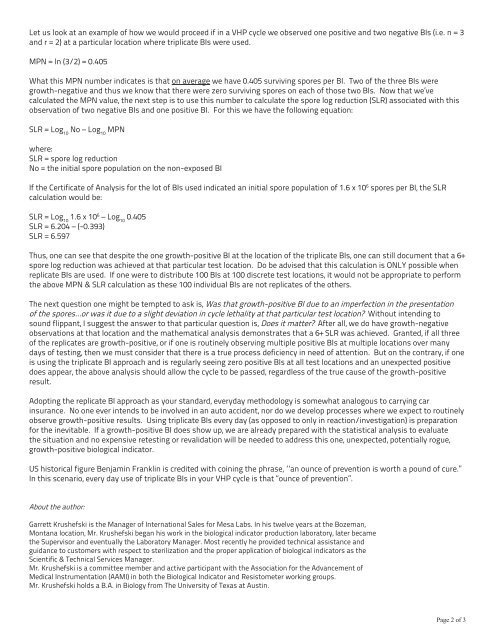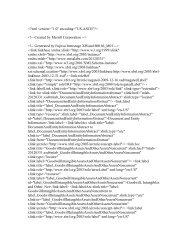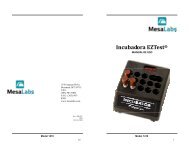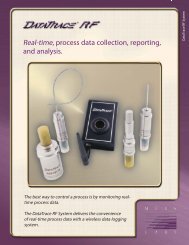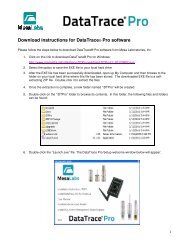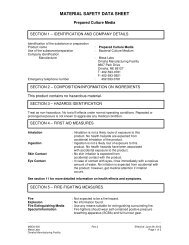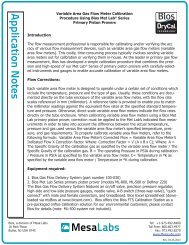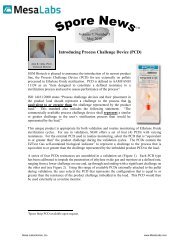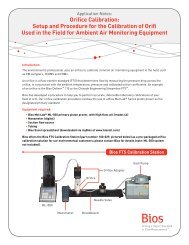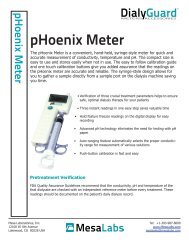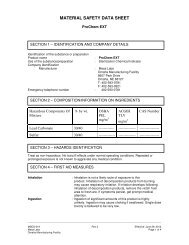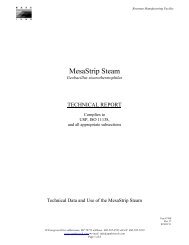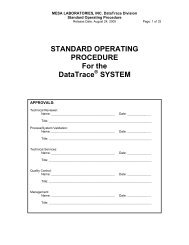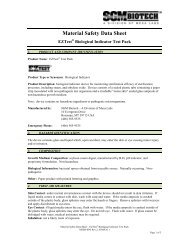Using replicate BIs to evaluate biodecontamination ... - Mesa Labs
Using replicate BIs to evaluate biodecontamination ... - Mesa Labs
Using replicate BIs to evaluate biodecontamination ... - Mesa Labs
Create successful ePaper yourself
Turn your PDF publications into a flip-book with our unique Google optimized e-Paper software.
Let us look at an example of how we would proceed if in a VHP cycle we observed one positive and two negative <strong>BIs</strong> (i.e. n = 3and r = 2) at a particular location where triplicate <strong>BIs</strong> were used.MPN = ln (3/2) = 0.405What this MPN number indicates is that on average we have 0.405 surviving spores per BI. Two of the three <strong>BIs</strong> weregrowth-negative and thus we know that there were zero surviving spores on each of those two <strong>BIs</strong>. Now that we’vecalculated the MPN value, the next step is <strong>to</strong> use this number <strong>to</strong> calculate the spore log reduction (SLR) associated with thisobservation of two negative <strong>BIs</strong> and one positive BI. For this we have the following equation:SLR = Log 10No – Log 10MPNwhere:SLR = spore log reductionNo = the initial spore population on the non-exposed BIIf the Certificate of Analysis for the lot of <strong>BIs</strong> used indicated an initial spore population of 1.6 x 10 6 spores per BI, the SLRcalculation would be:SLR = Log 101.6 x 10 6 – Log 100.405SLR = 6.204 – (-0.393)SLR = 6.597Thus, one can see that despite the one growth-positive BI at the location of the triplicate <strong>BIs</strong>, one can still document that a 6+spore log reduction was achieved at that particular test location. Do be advised that this calculation is ONLY possible when<strong>replicate</strong> <strong>BIs</strong> are used. If one were <strong>to</strong> distribute 100 <strong>BIs</strong> at 100 discrete test locations, it would not be appropriate <strong>to</strong> performthe above MPN & SLR calculation as these 100 individual <strong>BIs</strong> are not <strong>replicate</strong>s of the others.The next question one might be tempted <strong>to</strong> ask is, Was that growth-positive BI due <strong>to</strong> an imperfection in the presentationof the spores…or was it due <strong>to</strong> a slight deviation in cycle lethality at that particular test location? Without intending <strong>to</strong>sound flippant, I suggest the answer <strong>to</strong> that particular question is, Does it matter? After all, we do have growth-negativeobservations at that location and the mathematical analysis demonstrates that a 6+ SLR was achieved. Granted, if all threeof the <strong>replicate</strong>s are growth-positive, or if one is routinely observing multiple positive <strong>BIs</strong> at multiple locations over manydays of testing, then we must consider that there is a true process deficiency in need of attention. But on the contrary, if oneis using the triplicate BI approach and is regularly seeing zero positive <strong>BIs</strong> at all test locations and an unexpected positivedoes appear, the above analysis should allow the cycle <strong>to</strong> be passed, regardless of the true cause of the growth-positiveresult.Adopting the <strong>replicate</strong> BI approach as your standard, everyday methodology is somewhat analogous <strong>to</strong> carrying carinsurance. No one ever intends <strong>to</strong> be involved in an au<strong>to</strong> accident, nor do we develop processes where we expect <strong>to</strong> routinelyobserve growth-positive results. <strong>Using</strong> triplicate <strong>BIs</strong> every day (as opposed <strong>to</strong> only in reaction/investigation) is preparationfor the inevitable. If a growth-positive BI does show up, we are already prepared with the statistical analysis <strong>to</strong> <strong>evaluate</strong>the situation and no expensive retesting or revalidation will be needed <strong>to</strong> address this one, unexpected, potentially rogue,growth-positive biological indica<strong>to</strong>r.US his<strong>to</strong>rical figure Benjamin Franklin is credited with coining the phrase, “‘an ounce of prevention is worth a pound of cure.’’In this scenario, every day use of triplicate <strong>BIs</strong> in your VHP cycle is that ‘‘ounce of prevention’’.About the author:Garrett Krushefski is the Manager of International Sales for <strong>Mesa</strong> <strong>Labs</strong>. In his twelve years at the Bozeman,Montana location, Mr. Krushefski began his work in the biological indica<strong>to</strong>r production labora<strong>to</strong>ry, later becamethe Supervisor and eventually the Labora<strong>to</strong>ry Manager. Most recently he provided technical assistance andguidance <strong>to</strong> cus<strong>to</strong>mers with respect <strong>to</strong> sterilization and the proper application of biological indica<strong>to</strong>rs as theScientific & Technical Services Manager.Mr. Krushefski is a committee member and active participant with the Association for the Advancement ofMedical Instrumentation (AAMI) in both the Biological Indica<strong>to</strong>r and Resis<strong>to</strong>meter working groups.Mr. Krushefski holds a B.A. in Biology from The University of Texas at Austin.Page 2 of 3


